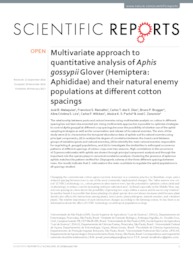Multivariate approach to quantitative analysis of Aphis gossypii Glover (Hemiptera: Aphididae) and their natural enemy populations at different cotton spacings.
Multivariate approach to quantitative analysis of Aphis gossypii Glover (Hemiptera: Aphididae) and their natural enemy populations at different cotton spacings.
Author(s): MALAQUIAS, J. B.; RAMALHO, F. de S.; DIAS, C. T. dos S.; BRUGGER, B. P.; LIRA, A. C. S.; WILCKEN, C. F.; PACHÚ, J. K. S.; ZANUNCIO, J. C.
Summary: The relationship between pests and natural enemies using multivariate analysis on cotton in different spacing has not been documented yet. Using multivariate approaches is possible to optimize strategies to control Aphis gossypii at different crop spacings because the possibility of a better use of the aphid sampling strategies as well as the conservation and release of its natural enemies. The aims of the study were (i) to characterize the temporal abundance data of aphids and its natural enemies using principal components, (ii) to analyze the degree of correlation between the insects and between groups of variables (pests and natural enemies), (iii) to identify the main natural enemies responsible for regulating A. gossypii populations, and (iv) to investigate the similarities in arthropod occurrence patterns at different spacings of cotton crops over two seasons. High correlations in the occurrence of Scymnus rubicundus with aphids are shown through principal component analysis and through the important role the species plays in canonical correlation analysis. Clustering the presence of apterous aphids matches the pattern verified for Chrysoperla externa at the three different spacings between rows. Our results indicate that S. rubicundus is the main candidate to regulate the aphid populations in all spacings studied.
Publication year: 2017
Types of publication: Journal article
Unit: Embrapa Cotton
Keywords: Algodão, Aphids, Aphis Gossypii, Chrysoperla externa, Cotton, Inimigo natural, Natural enemies, Pests, Praga
Observation
Some of Embrapa's publications are published as ePub files. To read them, use or download one of the following free software options to your computer or mobile device. Android: Google Play Books; IOS: iBooks; Windows and Linux: Calibre.
Access other publications
Access the Agricultural Research Database (BDPA) to consult Embrapa's full library collection and records.
Visit Embrapa Bookstore to purchase books and other publications sold by Embrapa.

